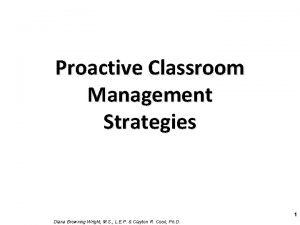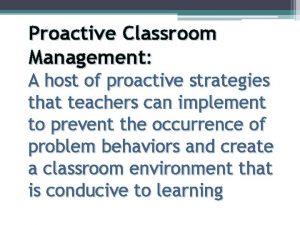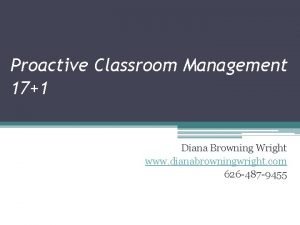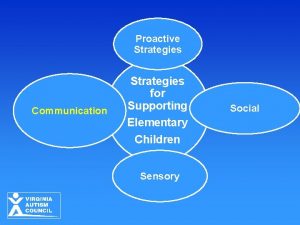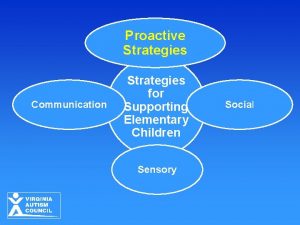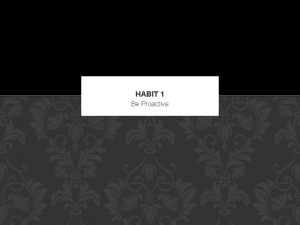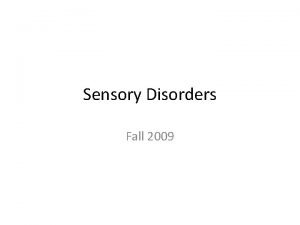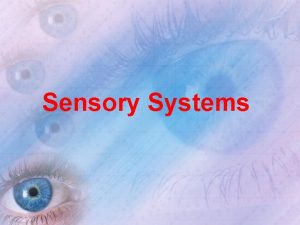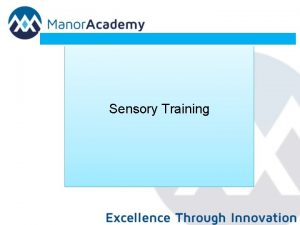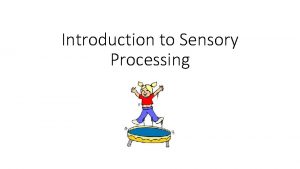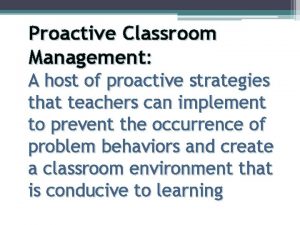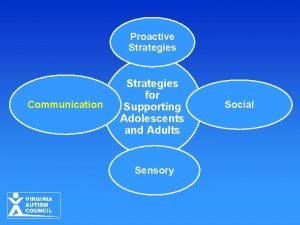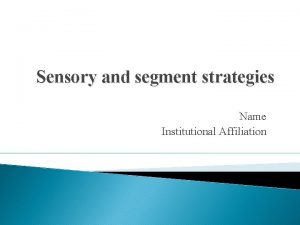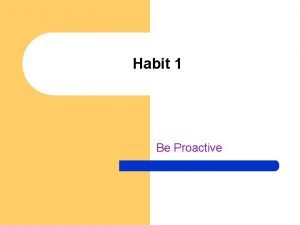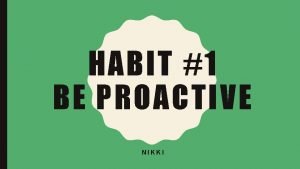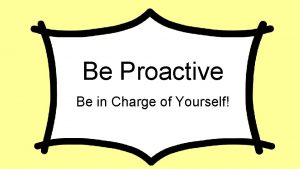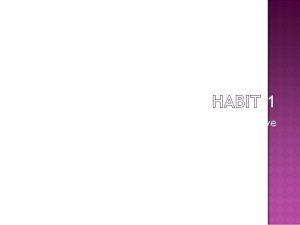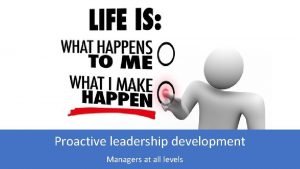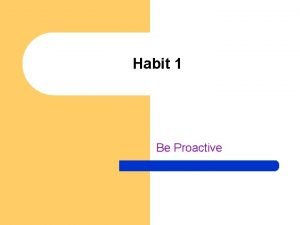Proactive Strategies Sensory Strategies for Supporting Elementary Children






































- Slides: 38

Proactive Strategies Sensory Strategies for Supporting Elementary Children Communication Social

Topics • Description of Sensory Systems • Sensory Processing Differences in Persons with ASD • Impact of Sensory Processing Differences • Strategies for School and Home • Components of a Sensory Diet

Description of Sensory Systems

The Sensory Systems Visual Touch Auditory Vestibular Taste Proprioception Smell

The Power Senses • Proprioception • Vestibular • Touch

The Power Senses Enable us to: • Feel safe and secure • Direct and sustain attention • Move without fear • Use our bodies automatically to perform motor tasks Barker, 2009

Sensory Processing Differences in Children with ASD


The Sensory Systems Visual Touch Auditory Vestibular Taste Proprioception Smell

In Their Own Words • “Touch from another • “It’s hard to understand what human being can be somebody is saying excruciating. ” when you constantly have to interrupt • “Tidal waves of your listening to stimulation” translate the words. ” • “Overpowering smells, distorted sights” • “The world is like an FM radio station that is not exactly tuned on the station. ”

In Their Own Words My senses seem to work on a quota system. I only have a set amount of energy or capacity to deal with incoming sensory information. I refer to this as my finite number of Sensory Processing Units. . . if I am in a dark room, I can tolerate more auditory chaos because my eyes are not busy. If I am in a quiet library, I can tolerate the quiet lights slightly longer because my ears aren't dealing with a lot of noise. Zosia Zaks

Activity Sensory Stations Let’s see how it feels!

Impact of Sensory Processing Differences

Behavior Response Continuum (Dunn) Hypo-responsive = under-responsive – Need more stimuli to react – Seek many sensory experiences Hyper-responsive = over-responsive – Can’t block out stimuli and get overwhelmed – Avoid or be unwilling to try new things

Sensory Defensiveness (Wilbarger) The over-activation of our protective sense Flight, fright, or fight reaction

Self-Regulation (Williams & Shellenberger) The ability to change your behavior and level of activity to fit the situation

Activity Sensory Motor Preference Checklist (Williams & Shellenberger) • What calms your engine down? • What “revs” your engine up?

Activity Go to the Child Profile & complete Sensory Questions 1, 2 and 3 1. What sensations appear to be difficult for this child to process? 2. What sensations appear to trigger a fight/flight/fright response for this child? 3. What behaviors does the child exhibit that may meet sensory needs?

What Would You Do? Steven’s Sensory Profile What sensory systems appear to be over-responsive for Steven? What sensory systems appear to be under-responsive for Steven? What state of arousal is Steven in for most of the day?

Strategies for School and Home

Accommodations and Modifications Physical adaptations – Room arrangement – Seating – Dividers / organizers – Materials – Quiet areas / break areas – Traffic flow

Accommodations and Modifications Visual accommodations – Use color or pictures – Reduce visual clutter – Use schedules – Address lighting needs – Indicate boundaries


Accommodations and Modifications Auditory modifications – Use music for transitions – Limit verbal exchanges – Allow for processing time – Minimize distracting sounds – Use headphones – Muffle or forewarn about loud sounds

Accommodations and Modifications Reduce distractions – Organize supplies, toys – Keep area clean – Cover or put away materials/toys not in use – Provide breaks – Be mindful of individual distractions (temperature, smell, visual, auditory)


What Else Can We Do to Help Steven?

Components of a Sensory Diet

Sensory Diet • Activities individualized based upon the child’s responses to sensory input • Activities implemented throughout the day and in a variety of settings • Activities proactively implemented as part of a natural routine

Examples of Activities Found in Sensory Diets Proprioception Vestibular • Pushing, pulling, tug of war • Carrying, lifting • Reaching, stretching • • Rocking Swinging Dancing Jumping on a trampoline • Power walking • Spinning

Examples of Activities Found in Sensory Diets Tactile Oral • Massaging • Sandwiching • Playing with textures • • Chewing Sucking Blowing Experimenting with taste/texture

Naturalistic Sensory Activities - Motor • Nature walking • Rolling, crawling, climbing • Running, jumping, dancing • Climbing stairs • Pulling wagon • • • Stretching Biking Singing Cooking Carrying library books

Naturalistic Sensory Activities - Play • Music • Construction toys (Megablocks, magnet or bristle blocks) • Puzzles or Playdoh • Textured toys and balls • Vibrating toys / pens

Sensory Emergency Kit Items: Sample List (Zaks, 2006) • Sunglasses • Walkman, earplugs, or noise cancellation earphones • Snacks/drinks/gum/candy • Tactile items/small toys • Extra clothing

Steven’s Naturalistic Sensory Activities 1. What are some possible goals for Steven? 2. What activities can we utilize and how can they be implemented?

Activity Go to the Child Profile and complete Sensory - Questions 4 and 5 4. What sensory activities and accommodations and modifications appear to help the child: A. Stay calm? B. Stay alert? C. Address fight/flight/fright? 5. How might you incorporate calming or alerting activities into this child’s day, and what activities would those be?

Assessment of Supports Is the child. . • More alert? • More tuned in? • Better able to focus? • Better able to attend? • Less explosive? • More interactive? • Less stressed? • Calmer? • Less unpredictable?

Closing Points • Seek to understand the unique sensory needs of the child and their impact on behavior • Provide modifications and accommodations, including sensory activities, to support each child’s unique sensory needs
 Diana browning wright
Diana browning wright 16 proactive classroom management strategies
16 proactive classroom management strategies Diana browning wright
Diana browning wright Att skriva debattartikel
Att skriva debattartikel Kung dog 1611
Kung dog 1611 Tack för att ni har lyssnat
Tack för att ni har lyssnat Tobinskatten för och nackdelar
Tobinskatten för och nackdelar Boverket ka
Boverket ka Hur ser ett referat ut
Hur ser ett referat ut Epiteltyper
Epiteltyper Varför kallas perioden 1918-1939 för mellankrigstiden
Varför kallas perioden 1918-1939 för mellankrigstiden Karttecken brant
Karttecken brant Formel för lufttryck
Formel för lufttryck Tallinjen
Tallinjen Rådet för byggkompetens
Rådet för byggkompetens Elektronik för barn
Elektronik för barn Borra hål för knoppar
Borra hål för knoppar Smärtskolan kunskap för livet
Smärtskolan kunskap för livet Bris för vuxna
Bris för vuxna Sura för anatom
Sura för anatom Frgar
Frgar Jiddisch
Jiddisch Typiska novell drag
Typiska novell drag Magnetsjukhus
Magnetsjukhus Indikation för kejsarsnitt på moderns önskan
Indikation för kejsarsnitt på moderns önskan Steg för steg rita
Steg för steg rita Toppslätskivling dos
Toppslätskivling dos Redogör för vad psykologi är
Redogör för vad psykologi är Bästa kameran för astrofoto
Bästa kameran för astrofoto En lathund för arbete med kontinuitetshantering
En lathund för arbete med kontinuitetshantering Mat för idrottare
Mat för idrottare Geometri för barn
Geometri för barn Svenskt ramverk för digital samverkan
Svenskt ramverk för digital samverkan Dikt exempel
Dikt exempel Ledarskapsteorier
Ledarskapsteorier Klädsel i rom
Klädsel i rom Vilken grundregel finns det för tronföljden i sverige?
Vilken grundregel finns det för tronföljden i sverige? Förklara densitet för barn
Förklara densitet för barn Ministerstyre för och nackdelar
Ministerstyre för och nackdelar
